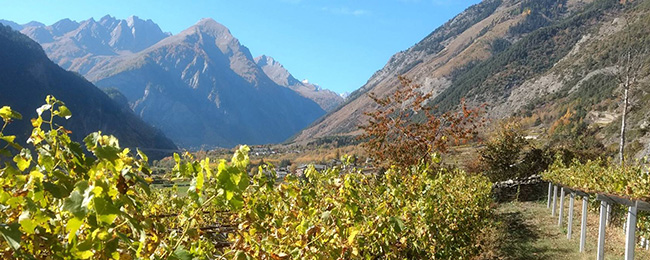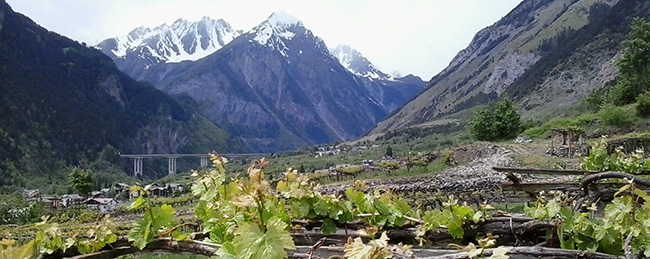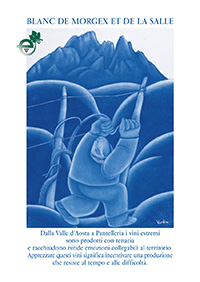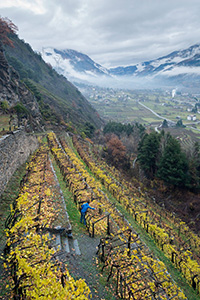
As far northwest as you can go in Italy, tucked away in the Alps beneath looming Mont Blanc, Europe’s highest peak, is Valle d’Aosta, the smallest viticultural region in Italy both in terms of size and production. Bordering both France and Switzerland to the north and Italy’s Piemonte region, to the south, the Aosta Valley is a winding network of vineyards, some on dizzyingly, steep slopes at the highest elevations of any vineyards in Europe. Sitting on the sheltered side of the Alps, means the Aosta Valley falls in a rain shadow and enjoys warm, dry summers. Pergolas and other techniques in the vineyards are used by the vignerons to mitigate the extremes of the nights, diurnal temperature variations.
The thin, rocky soils provide a stressful environment where vines must work hard to survive. Along with the diurnal temperatures, this stress allows for the production of richly flavored, concentrated wines. The dramatic topography and diminutive size of the valley mean that the area available for viticulture is limited and finite. As much of the valley floor, with its mineral-rich, well-watered soils, is simply too fertile for quality viticulture, the best Valle d’Aosta vineyards begin on the lower slopes and climb to altitudes of around 1200 meters above sea level.
To frame the Valle d’Aosta statistically, a mere 330,000 cases are produced and only 10% of the region's annual production qualifies for DOC status and the majority of that is sold locally. Seventy five percent of the area's production is red wine made primarily from Pinot Noir, Gamay and Petit Rouge varieties. Seventy five percent of the Aosta Valley’s total wine production comes from several cooperative wineries, which between them have around 450 grower-members. The viticultural part of the valley extends between Morgex et se la Salle (home to some of Europe's highest vineyards) and Donnas – a distance of about 75 kilometers.
It is in this environment that the cooperative, Cave Mont Blanc de Morgex et La Salle was formed in 1983. The cooperative is producing white wine from Aosta’s only indigenous, white grape, Prie Blanc, along with the only Methodo Classico, sparkling wines produced in the valley, also from Prie Blanc. Cave Mont Blanc represents 80 small, artisan, grower members, each too small to produce and bottle their own wine, who control a total of 18 hectares, which translates to 90% of all harvested grapes in the prime vineyards between Morgex and La Salle.
The Cave Mont Blanc believes in a philosophy of strict non-interventionist, natural wine production, always respecting the terroir and the traditions and culture of the territory. Indigenous yeasts are used in the stainless steel, temperature controlled, fermentation. The wine is carefully racked and does not undergo clarification or stabilization. The wines are bottled to order, allowing maximum freshness throughout the year. The temperature and dryness of the air make soil and vine disease scarce allowing the cooperative to use European, non-grafted vines, which results in healthier, longer lived wines with greater purity and character.
Vini Estremi (exteme wine) is harvested from Cave Mont Blanc’s highest vineyards at 1200 meters; among the highest in all Europe. Produced 100% from the Prié Blanc grape, in the glass, the wine is light, straw yellow with green reflections. The Vini Estremi offers delicate but precise aromas and concentrated, ripe, fruit flavors of white stone fruit, pineapple, white flowers, lemon peel and flint with a “granite” sensation. On the palate, it is fresh and very mineral throughout with a laser beam of acidity that awakens the taste buds and a bright, clean finish that hints at bitter almond, which produces an immediate return to your glass for the next taste.
Total production: 600 cases


